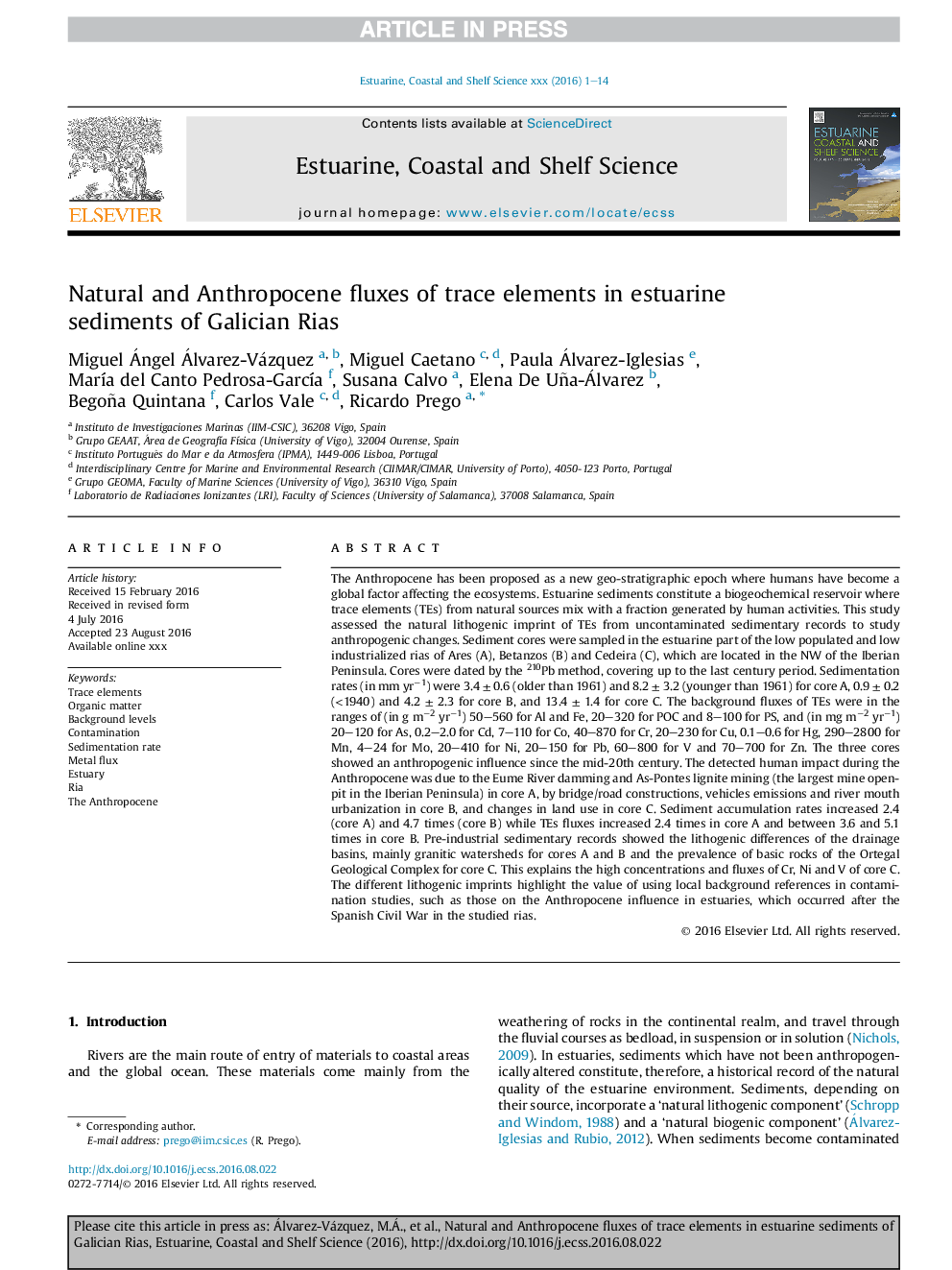| کد مقاله | کد نشریه | سال انتشار | مقاله انگلیسی | نسخه تمام متن |
|---|---|---|---|---|
| 8885169 | 1626604 | 2017 | 14 صفحه PDF | دانلود رایگان |
عنوان انگلیسی مقاله ISI
Natural and Anthropocene fluxes of trace elements in estuarine sediments of Galician Rias
ترجمه فارسی عنوان
فلوهای طبیعی و آنتروپوکسن عناصر کمیاب در رسوبات استوایی ریاس گلیسیری
دانلود مقاله + سفارش ترجمه
دانلود مقاله ISI انگلیسی
رایگان برای ایرانیان
کلمات کلیدی
موضوعات مرتبط
مهندسی و علوم پایه
علوم زمین و سیارات
زمین شناسی
چکیده انگلیسی
The Anthropocene has been proposed as a new geo-stratigraphic epoch where humans have become a global factor affecting the ecosystems. Estuarine sediments constitute a biogeochemical reservoir where trace elements (TEs) from natural sources mix with a fraction generated by human activities. This study assessed the natural lithogenic imprint of TEs from uncontaminated sedimentary records to study anthropogenic changes. Sediment cores were sampled in the estuarine part of the low populated and low industrialized rias of Ares (A), Betanzos (B) and Cedeira (C), which are located in the NW of the Iberian Peninsula. Cores were dated by the 210Pb method, covering up to the last century period. Sedimentation rates (in mm yrâ1) were 3.4 ± 0.6 (older than 1961) and 8.2 ± 3.2 (younger than 1961) for core A, 0.9 ± 0.2 (<1940) and 4.2 ± 2.3 for core B, and 13.4 ± 1.4 for core C. The background fluxes of TEs were in the ranges of (in g mâ2 yrâ1) 50-560 for Al and Fe, 20-320 for POC and 8-100 for PS, and (in mg mâ2 yrâ1) 20-120 for As, 0.2-2.0 for Cd, 7-110 for Co, 40-870 for Cr, 20-230 for Cu, 0.1-0.6 for Hg, 290-2800 for Mn, 4-24 for Mo, 20-410 for Ni, 20-150 for Pb, 60-800 for V and 70-700 for Zn. The three cores showed an anthropogenic influence since the mid-20th century. The detected human impact during the Anthropocene was due to the Eume River damming and As-Pontes lignite mining (the largest mine open-pit in the Iberian Peninsula) in core A, by bridge/road constructions, vehicles emissions and river mouth urbanization in core B, and changes in land use in core C. Sediment accumulation rates increased 2.4 (core A) and 4.7 times (core B) while TEs fluxes increased 2.4 times in core A and between 3.6 and 5.1 times in core B. Pre-industrial sedimentary records showed the lithogenic differences of the drainage basins, mainly granitic watersheds for cores A and B and the prevalence of basic rocks of the Ortegal Geological Complex for core C. This explains the high concentrations and fluxes of Cr, Ni and V of core C. The different lithogenic imprints highlight the value of using local background references in contamination studies, such as those on the Anthropocene influence in estuaries, which occurred after the Spanish Civil War in the studied rias.
ناشر
Database: Elsevier - ScienceDirect (ساینس دایرکت)
Journal: Estuarine, Coastal and Shelf Science - Volume 198, Part B, 5 November 2017, Pages 329-342
Journal: Estuarine, Coastal and Shelf Science - Volume 198, Part B, 5 November 2017, Pages 329-342
نویسندگان
Miguel Ángel Álvarez-Vázquez, Miguel Caetano, Paula Álvarez-Iglesias, MarÃa del Canto Pedrosa-GarcÃa, Susana Calvo, Elena De Uña-Álvarez, Begoña Quintana, Carlos Vale, Ricardo Prego,
